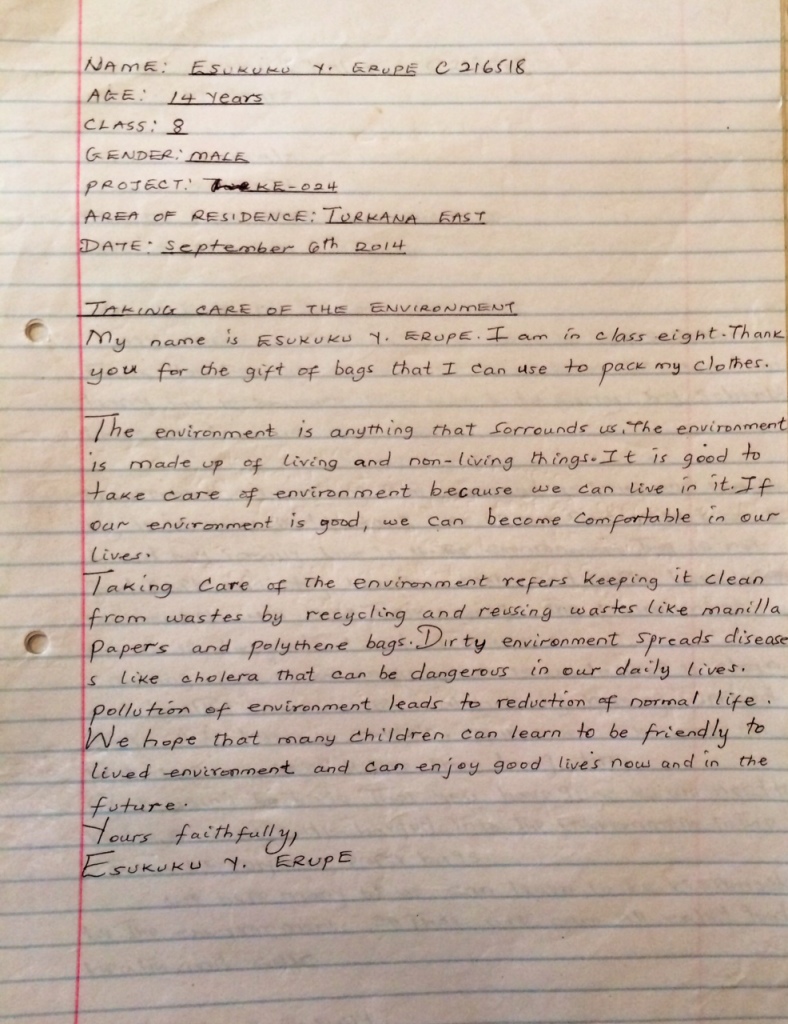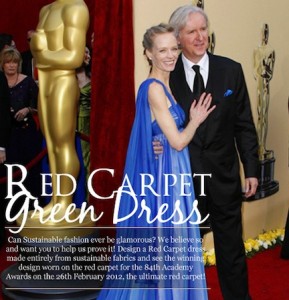The innovative business practice of shared value, whereby profit-driven entities undertake social and environmental missions, naturally prompts contemplation of the possibility of legitimate coexistence of such normally divergent positions. Any such discussion is especially significant today as we celebrate the 45th anniversary of Earth Day, a day set aside by more than 192 countries and 22,000 partners to “activate the environmental movement worldwide, through a combination of education, public policy, and consumer campaigns.”[1]
Name: Esukuku Y. Erupe C 21651
Age: 14 Years
Class: 8
Gender: Male
Area of Residence: Turkana East
Date: September 6th 2014
Taking Care of the Environment
My name is Esukuku Y. Erupe. I am in class 8. Thank you for the gift of bags that I can use to pack my clothes.
The Environment is anything that surrounds us. The environment is made up of the living and non-living things. It is good to take care of the environment because we can live in it. If our environment is good, we can become comfortable in our lives.
Taking care of the environment refers to keeping it clean from waste by recycling and reusing wastes like manilla papers and polyethylene bags. Dirty environment spreads diseases like cholera that can be dangerous in our daily lives. Pollution of the environment leads to reduction of normal life. We hope that many children can learn to be friendly to the environment and can enjoy good lives now and in the future.
Yours Faithfully,
Esukuku y Erupe
Nature seems to take our breath away. Whether it is the sight of the Adirondack Mountains from the summit of Dix or the sunset over the Chesapeake Bay from Thomas Point, the beauty of nature takes our breath away. Even New York City native urbanites take pride and find pleasure from the nature in Central Park. Yet in our fast-paced, technology infused, world, we find it difficult to secure time away from the 9-5 to explore and admire the natural world around us. If only there was a way to combine the beauty of nature with the constant callings of our rushed city lives…
In a city, such as NYC or DC, there are many “dead” spaces, such as concrete roofs and walls of buildings, that provide nothing but support for the building. Here, we present to you a symbiotic relationship between city and nature. Green roofs and green walls are becoming more and more popular with environmental activists and businesses looking to reduce long-term costs and improve the environment around them.
What are green roofs and walls?

Green roof on Chicago City Hall

Green wall in Paris
In a nutshell they are the product of taking inanimate flat surfaces and turning them into living, breathing, pieces of art that benefit the environment and society. They are soil based structures that can contain many different species of plants, depending on what your ultimate goal is. Most green roofs are made up of very resistant plants that do no require much attention. These plants are most often Sedum, which are small, brightly colored flowers that attract butterflies and and honey bees (oh how important!!) as well as being drought resistant and low maintenance [1]. But don’t let that hold you back. Depending on the resources you have at your disposal, there are intensive green roofs that can contain a high variety of plants even including medium to large trees!
Not only are green roofs and walls aesthetically pleasing, but they contain many environmental, economic, and social benefits. The below list of benefits is paraphrased from page 2 of the Green Roof Toolkit put together by the Anacostia Watershed Society (AWS).
Environmental:
– Creation of wildlife habitat
– Reduction of storm water runoff into watershed areas
– Reduction of urban temperatures in hot weather
– Improvement of the air quality
Social:
– Creation of desirable green space
– Provide an aesthetic appeal to urban landscapes
– Provide more space for growing food
– Educational space to teach young children about the environment
Economic:
– Provides sound insulation for the building
– Monetary credits for storm water impact
– Increase of property values
– Decrease in energy costs
– Reduction of waste and landfill usage
– Increases the life of the roof
Wow! Such benefits! Would you believe me if I told you that not only do you and your city get to reap all of these benefits, but some cities such as DC are offering subsidies to help with the costs of green roof construction! The District Department of the Environment (DDOE) is currently offering a green roof rebate program that will pay $7-10 per square foot to

Green wall on PNC headquarters in Pittsburgh, PA
incentivize people to invest in green roofs [3]. Even better is that the Anacostia Watershed Society is working in tandem with the DDOE to increase the subsidy to $15-20 per square foot!
If you live in the district and you have an interest in remodeling your roof, contact the AWS. They will work with you to find a contractor and a price that fits your resources.
Green walls are not only for the individual household. They can also be great ways to advertise and market your company or product! As you can see on the right, PNC headquarters in Pittsburgh has taken the concept to a beautiful level with the green wall on their building. This green wall, the largest in North America, is 2,380 square feet with over 14,000 living plants! [4]
Nature is a beautiful thing LGBG followers. So, with the mounds of benefits and the lovely aesthetics of nature in our concrete jungles, let’s work as one to push for green roofing and walls throughout our country!
Resources for this article:
[1] http://www.bhg.com/gardening/plant-dictionary/perennial/sedum/
[2] http://green.dc.gov/sites/default/files/dc/sites/ddoe/publication/attachments/GR%20Toolkit%2012.22.11.pdf
[3] http://green.dc.gov/greenroofs
[4] http://www.jetsongreen.com/2009/09/the-largest-green-wall-in-north-america.html
Over the past years, the Oscars and sustainability have proven to be an award-winning combination. On Sunday, people globally will tune in to the 86th Academy Awards presentation to celebrate the best movies over the past year. It is important to salute the Academy of Motion Picture Arts and Sciences (The Academy) for its commitment to “green” living.
It does not come as a surprise that the organization would have sustainability as part of its agenda considering that so many of its members are outspoken supporters of the green movement, and they often lend their faces and financial support to environmental, health and social concerns. The popularity of many of these celebrities, including, but not limited to George Clooney, Angelina Jolie, Brad Pitt, Leonardo DiCaprio, Orlando Bloom and Selma Hayak, goes a long way to raise awareness of and garner support for environmental, health and social issues.
The commitment of the Academy to raise awareness of environmental issues and garner support through example also is noteworthy. This effort begins with the selection of the Dolby Theater, formerly the Kodak Theater, as the venue for the annual event. With this long-term agreement to be the home of the Oscars, Dolby is committed to environmental sustainability.
Global Green Oscar Week Kickoff
The Academy validated its commitment to sustainability with its annual kickoff by Global Green USA. This year the celebration was “dedicated to rebuilding communities subject to environmental degradation.” This organization now is the green event of Oscar week. It seeks to raise “conscience” about energy conservation, and this year included celebrities speaking about driving to the Oscar celebration in hybrid cars. This party featured a zero-waste plant-based dinner followed by a live auction that raised more than $20,000 to support its causes.
Red Carpet Green Dress
Second only to the actual awards ceremony, the highlight of Oscar night is the fashion displayed on the red carpet, and here some designers are featuring green dresses. Perhaps the most notable is Red Carpet Green Dress, who is marking its fifth anniversary for this event. This organization is the brainchild of Suzy Amis Cameron, wife of James Cameron, who, during press tours for Avatar (a Cameron film), sought to draw attention to the importance of sustainability in the fashion industry. Mrs. Cameron notes that “[w]hile there are still great strides to be made, it’s important to point out that there are a greater number of sustainable resources available to designers today than there were five years ago.”[1] This year’s Oscars Red Carpet will feature actress Olga Kurylenko wearing the design by this organization. Olga’s accessories also are selected with concern for ethical consumerism. Her limited edition vegan Red Carpet shoes are supplied as a result of a collaboration between PETA and Beyond Skin.
Meanwhile, on the men’s side, Kellan Lutz (Legend of Hercules) will be wearing the first sustainable tuxedo for Red Carpet Green Dress. This tuxedo was designed by Jomnarn Dul for H Brothers and was constructed from recycled materials.
Dining with a Conscience
This year’s Governor’s Ball, the official dinner held following the award ceremony, will be created and officiated by Wolfgang Puck (celebrating 20 years in this role). To the delight of the green movement, the theme will be the transcendent wonder of nature, with a display of lush vertical gardens under the stars that invite guests to mingle and celebrate nature. The menu includes a prominent focus on vegan dishes. All of the food will range from one-bite hors d’oeuvres to small-plate entrees. Once again, these choices are indicative of the Academy’s concern and focus on the need to raise awareness of the environment and sustainability.[2]
The Academy Awards is one of the most popular events globally and is viewed by many people, thereby creating an excellent opportunity to raise awareness about green initiatives and sustainability. We are proud to present background information on the efforts of the Academy to make a difference in the movement for sustainability.
__________________
Resources for this article:
1. http://redcarpetgreendress.com/home/olga-kurylenko-to-reveal-the-fifth-design-from-suzy-amis-camerons-red-carpet-green-dress-on-the-oscar-carpet.
2. http://fbworld.com/2014/02/24/starring-role-for-master-chef-wolfgang-puck-at-86th-academy-awards-governors-ball.
Being that it is a requirement of living, it is likely that you have seen a grocery store in your lifetime. (If not, congrats to you for this incredible feat in modern society). Among the common items of bread, eggs, and cheese that you would normally find in the grocery store is the now ubiquitous Greek Yogurt section. Popular for being rich in protein, and its smooth texture, Greek yogurt has taken off as an industry within the past five years. In fact, “…Yogurt production in New York…has tripled between 2007 and 2013.”[1] What yogurt companies and John Stamos have not told you however are the consequences the production of their products have had on the environment.
Unlike traditional yogurt, the Greek variety, “…Yields huge quantities of acid whey, a byproduct that kills aquatic life during decomposition.” In the production cycle, acid whey (which is common component in the making of inexpensive butters and creams) is one of the byproducts that separates from milk after it has been curdled.[2] Yet, because of the aforementioned boom in production, yogurt companies are left with a tremendous amount of waste that cumulatively can greatly impact our oceans, rivers, and streams. Acid whey naturally takes away oxygen from water which has the effect of progressively killing any aquatic life in the area. For example, after an Ohio cheese factory accidentally spilled acid whey into nearby Sandy Creek, close to 5,400 fish were killing along the 1.5 mile river.[3] These figures are pretty extraordinary, but can only provide a glimpse into the potential environmental ramifications if a larger scaled spill were to happen.
Currently, for every three or four ounces of milk, Chobani and other companies can produce only one ounce of creamy Greek yogurt. The rest becomes acid whey.”[4] So what can we do to reverse this trend? According to The Verge and The Modern Farmer several sustainable options are currently being explored. The most promising idea in use is located at a farm in Scipio Center, N.Y where they have successfully turned acid whey into methane, which then is converted into usable electricity. In a simplified and less disgusting version of the process, acid whey and manure are combined in tanks with heat for approximately 20 days. Here the cultures in acid whey break down the contents of the mixture which, in this case, releases methane embedded within the manure where the gas is used as a raw material for electrical generators which power the farm.
Yet, the anaerobic digesters which are required tools for the New York farm require millions in capital investment and are not likely to be available to the local farmer. As a result, we need to cultivate more practical ideas to meet this growing challenge which faces our environment and aquatic life. Here at LGBG we want to empower you with this information to go out and make a difference. Together lets collaborate and inspire to create a solution so that we can all live green, and be green.
Since 1970, Earth Day has been celebrated as a worldwide day of events to demonstrate commitment to the environment, and as such, it is a day that everyone can celebrate, big or small. We here at LGBG urge all of our readers to get involved and plan some activity for the day. Of course, we have a few suggestions.
1. Plant something. It could be a garden, large or small, or maybe a balcony garden. Also, it could be one vegetable or flowering plant. This could be a fun project to do with children. They will love caring for a flower or vegetable plant, and imagine their pride when they see the end result, a beautiful blossom or a vegetable that they can consume. If time is too short or the weather is not amenable to planting something, consider joining the National Arbor Foundation (http://www.arborday.org/) and donating seedling trees to be planted in designated areas sorely in need of reforestation.
2. Use recyclable bags. If you go shopping on Earth Day, refuse to use a plastic bag. Take a recyclable bag from home or purchase one for the articles you purchase. Try storing these bags in your car to be used for future shopping trips.
3. Park the car. Turn off the television. Take a walk. Play games outside. Relax and celebrate Mother Nature.
4. Pledge an act of green. There are many environmental and green organizations that would appreciate your financial support. We here at LGBG ask that you consider supporting Africa Inside (http://africainside.org/globalconservation/one-wordplastics/) in its drive to rid the African countryside of plastic bags and No Water No Life (http://nowater-nolife.org/index.html), a wonderful organization that “documents North American and African watersheds to illustrate degradation of fresh water resources and stewardship solutions“.
5. Reduce your carbon footprint starting tomorrow. This can be done by skipping meat at a meal, taking public transportation, and turning off the lights when leaving a room.
These are just a few suggestions to get engaged in tomorrow’s Earth Day Celebration. Others can be found on the Internet and on community boards. Also, once you choose an activity, make sure you upload a picture of it on “The Face of Climate Change” photo mosaic at www.earthday.org/2013.
Earth Day is an annual celebration open to anyone interested in the protection of the environment and sustainability. To join in this global movement to protect our natural resources and to ensure a healthy world for future generations is a great path on the journey to live green, be green.
Pretty soon, a new raw material is going to be used to fuel power stations. In a promising development for green energy, the East London town of Beckton will become the world’s largest power station run on cooking waste. In the proposed plan, ”Thirty tons a day of waste will be collected from leftover cooking oil supplies at eateries and manufacturers, fat traps in kitchens and pinchpoints in the sewers – enough to provide more than half the fuel the power plant will need to run.” The end result is that the plant will be able to produce 130 Gigawatt hours a year of renewable energy, enough to power 40,000 average-sized homes. In addition, the project has another benefit in that, if the energy goes unused, the output will be able to be used by other Londoners outside of Beckton. As stated by Andrew Mercer, the chief executive of Thames Water and Utility company “2OC” who will purchase energy from the new power plant, “Our renewable power and heat from waste oils and fats is fully sustainable. When Thames doesn’t need our output, it will be made available to the grid meaning that power will be sourced, generated and used in London by Londoners.”[1]
The Beckton plant will not be unique with respect to using oils as an input for power plants. In fact several power plants, including the Wärtsilä Oil Power Plant in Finland already utilize the technology and have had success with energy output. Several other benefits arise when using oil as the primary input for energy extraction:
- Fast start-up, less than 5 min from hot standby to full plant load
- High efficiency resulting in low generation costs
- Excellent long-term reliability[2]
Yet, it will be interesting to see what impact a power plant run entirely on cooking oils and fats will have on the environment. Much more refining will be needed in order to extract the pure biofuel and a powerplant of this kind is truly unique, despite sharing similarities with existing powerplants that run on oils. Nonetheless, it is refreshing to see that sustainable and socially conscious decisions are being made whose potential ramifications will affect millions of people. The thought of using cooking waste, which largely goes unused, being transformed into an energy source available to a growing population whose energy usage is outpacing supply, is exciting and will open the door for more projects with energy efficiency in mind. If successfully implemented, Beckton’s powerplant will truly question the way in which we fuel powerplants, and will show how we can transform trash into a pseudo green-conscious-treasure available to all.
With the Oscar’s upon us, our minds as a nation tend to drift towards the extravagance as a result of watching global icons in Hollywood’s biggest party of the year. Opulence and decadence are the most appropriate adjectives to describe the evening and more specifically the gowns and tuxedos worn to the event. It is fairly common for dresses to cost tens of thousands of dollars as designers use the star-studded event to promote their fashion lines and brands on the most expensive mannequins money can buy.[1] Despite the lavishness however, many of these actors and actresses are heavily involved with charities and humanitarian efforts. Their global statuses help to raise tremendous amounts of money for causes they deem valuable, or even crucial for society to survive moving forward. Leonardo DiCaprio for example has consistently sought to bring about awareness of environmental issues through his Leonardo DiCaprio Foundation (LDF). DiCaprio’s latest project is called LYON, which is an organic and fair trade coffee company, whose proceeds support LDF’s other sustainable ventures which include, but are not limited to, “…Wildlife protection, forest preservation, clean water, and climate change.”[2]
In addition, Colin Firth, who currently is working on a project to help save the Brazilian indigenous Awa tribe, who are being threatened as a result of illegal logging of the Amazon Rainforest, is among a growing population of celebrities who are involved with charities and humanitarian efforts geared around the environment and green issues.[3]
And while it is difficult to say that some charities are more valuable or important than others, the impact of green initiatives and sustainability affect us all to some degree or another. I realize that the focus of the Oscars (or any other awards show in general) is not charity i.e. the Guardian Charity Awards. Yet, a lot of good can be done by a simple celebrity plugin. Actors and actresses are already asked what and who they are “wearing” for the evening. By wearing a green inspired dress or tuxedo and mentioning that to the public is relatively harmless, and is in line with the questioning they already receive from reporters for the night. Imagine how much awareness for green clothing can be provided by even a single celebrity endorser. For example, just think about how many eyeballs watch an event like the Oscar’s. Now imagine the amount of attention a green clothing initiative would receive if say a George Clooney wore a hemp fused Armani tuxedo or a Jennifer Lawrence wore a Donna Karen dress made from recyclable materials. The amount of good press for a celebrity who endorses such a movement and for the designer, who took time out to make a sustainable and fashionable garment for a celebrity to wear, would only be equaled by the amount of exposure for the green clothing movement. Celebrities are already involved with green charities. Yet, their statuses as global icons will only help to push a movement like sustainable clothing quickly into mainstream if they choose to endorse it. What a personal and humanitarian statement that would make if a celebrity showed up to an event that is broadcast worldwide in elegant clothing made from green materials. Let’s push our celebrities to wear sustainable clothing and to promote the movement’s ideals to a worldwide audience. In that way the world can see the possibilities of sustainable clothing and can further help to promote a world in which we live green, and be green.
As we march, rally and cajole our elected officials to address the issues of global warming and climate change, it is important that we include our homeowners associations (HOA) in the group of elected bodies who must be committed to this effort. According to data by the Community Associations Institute, [1] there are more than 323,600 homeowners’ associations in the United States, resulting in jurisdiction over 63.4 million Americans.
HOAs have quasi-political powers over its residents. In many cases, they represent “government among friends,” where rules and covenants are adopted and enforced regarding upkeep of facilities to ensure that these communities look good and function well. The HOA is an excellent source to incorporate sustainability practices, but some serious nudging by residents is needed to accomplish this. In fact, HOAs in the past have been notable for employing restrictive practices that are contrary to a green lifestyle, all in the name of aesthetics. Some of these practices include the prohibition of outside organic gardens that feature edible flowers and fruit, banning the use of outdoor clothes-drying and prohibiting the use of solar panels.
The first step to engage the HOA in going green is to get involved in the election of officers to the board of directors. Often the individuals who serve on these boards are cajoled by the current officers to simply be a warm body to fill a vacant seat or they are individuals who join the board to fulfill a specific agenda– approval for a new playground or installation of speed bumps are immediate examples that come to mind. Imagine the impact that a board of directors who are committed to climate change, living green and sustainability would have on the community. In addition to working to have a beautiful neighborhood, the community could adopt a plan for eco-landscaping, [2] which promotes a healthy environment with the selection of flowers and deciduous trees that save the soil, require fewer pesticides and herbicides and need less water to survive.
Those “green voices” on the board of directors of the HOA also encourage discussion on green technology. The board could then make informed recommendations regarding sustainable products, and they may be able to get group discounts for some items. This alone will spike residents’ interests in programmable thermostats, hot tub timers, CFL bulbs, motion sensors and green appliances. Also, those “green voices” on the board could rally the residents to force the HOA officers to review restrictive covenants and remove the provisions that thwart sustainability, such as the prohibition of the use of solar panels.
The point to be made here is that the HOA should represent the community. After all, the residents pay dues to live in these neighborhoods, and they should have a voice in the management of their developments. The residents have the right to property management companies which truly look out for their interests, and the companies selected to do this should be versed in green living and capable of directing the board on instituting policies and procedures which help the developments they serve to be healthy communities in addition to being clean and beautiful.[3]
As we approach the season for HOA annual meetings and elections, we here at LGBG hope that each of you who live in communities served by homeowners associations use this opportunity to elect officials who will truly represent you and promote your agenda to live green, be green.
Sources for this article:
1. http://switchboard.nrdc.org/blogs/kbenfield/coercion_by_contract_how_homeo.html.
2. http://www.sustland.umn.edu/maint/trees.html.
3. http://melrosemanagement.com/news.cfm/mode/details/id/6302/tips-for-going-green-with-your-hoa.










